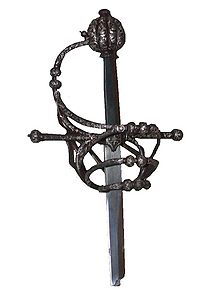Handle
With the term stapling or hilt (also Gehilze , Grip , Griffhilze ), the previously existed mostly wooden handle of edged weapons called and some hand tools. He takes z. B. the Erl ( Angel ) on.
Tools
Tools with a handle include knives , files (file handles), rasps , chisels or scribers . In the 19th century, in the course of industrialization and specialization, the staple and shell cutter became a profession . They made wooden exercise books for the cutlery industry, for example.
Even nowadays, handles are often made of wood, but often also (for knives, for example) made of plastic. With high-quality tools, the booklets are usually interchangeable and can therefore be replaced if necessary, for example if they are loose.
weapons
Hilted weapons are bladed weapons and most striking weapons . The handle is part of the vessel . The vessel is available in many designs, from the handle with a simple toggle, which is supposed to prevent the hand from slipping on the blade, to the basket vessel, which almost completely encloses the hand. In many weapons, the rear end was designed as a relatively heavy pommel , on the one hand to better balance the blade, on the other hand as a percussion instrument.
In addition to the decorative effect to be achieved, the design of the grip surface should also ensure that a grip weapon is held well in the hand:
- structured: the surface is interrupted by horizontal steps or bulges
- swollen: a cylinder-symmetrical handle with the largest cross-section roughly in the middle, which decreases towards the ends, or an asymmetrical handle with a thickened middle section at the front
- tortuous: a bead runs spirally along the surface
- ribbed: the surface is roughened with small ribs
- corded: the surface is diagonally roughened ("fish skin")
The basic handle shapes are (the numbers correspond to the numbers in the illustration):
Symmetrical handles
- Sword, epee and dagger hilt
- Sword, epee and dagger hilt, but swollen
- Sword, epee and dagger hilt, but articulated
- Sword, epee and dagger hilt, but twisted
Asymmetrical handles
- Saber hilt
- Saber hilt, but swollen
- Knife handle, continuous tang, riveted
This is where the phrase "having the book in hand" comes from .
See also
literature
- Gerhard Seifert: Technical Terms for Edged Weapons , 2007 Technical Terms for Edged Weapons (PDF; 3.66 MB)
Individual evidence
- ↑ GEHILZ, n. In: Jacob Grimm , Wilhelm Grimm (Hrsg.): German dictionary . 16 volumes in 32 sub-volumes, 1854–1960. S. Hirzel, Leipzig ( woerterbuchnetz.de ).
- ↑ Seifert: Specialized Weapons Knowledge , 2007
- ↑ Seifert: Specialized Weapons Knowledge , 2007


